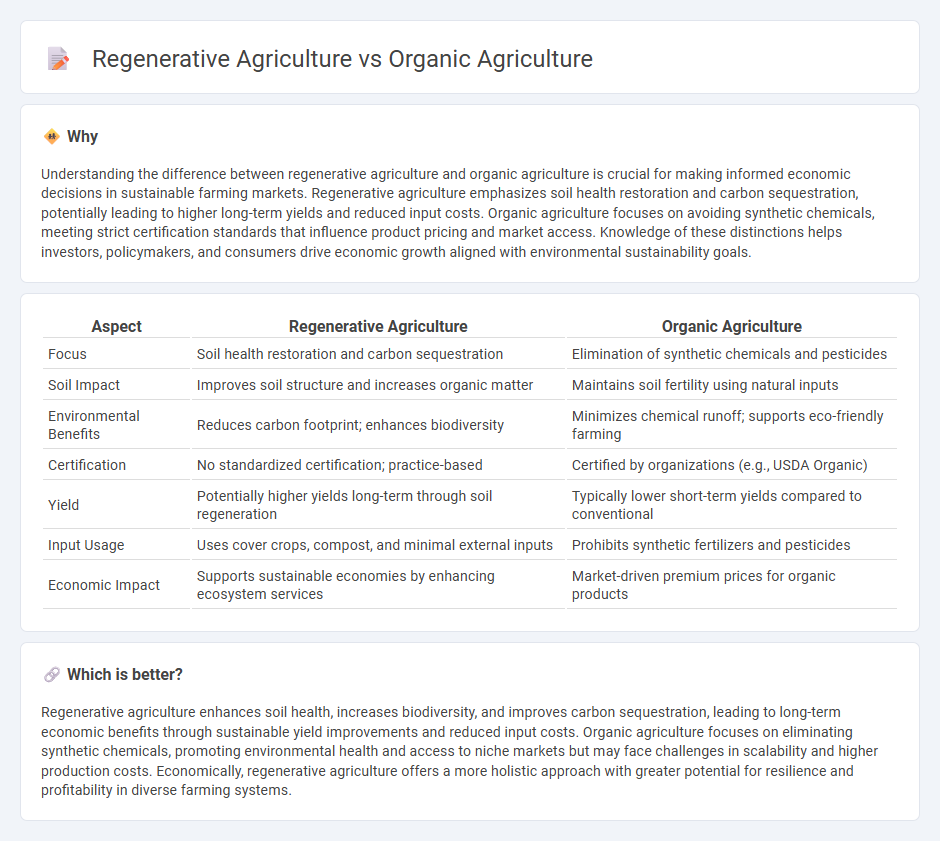
Regenerative agriculture focuses on restoring soil health and enhancing biodiversity through practices like cover cropping, no-till farming, and crop rotation, promoting long-term ecosystem resilience. Organic agriculture emphasizes the avoidance of synthetic chemicals and GMOs, prioritizing natural inputs and certification standards to produce healthier food. Explore the economic impacts and sustainability benefits of these farming methods to understand their roles in modern agriculture.
Why it is important
Understanding the difference between regenerative agriculture and organic agriculture is crucial for making informed economic decisions in sustainable farming markets. Regenerative agriculture emphasizes soil health restoration and carbon sequestration, potentially leading to higher long-term yields and reduced input costs. Organic agriculture focuses on avoiding synthetic chemicals, meeting strict certification standards that influence product pricing and market access. Knowledge of these distinctions helps investors, policymakers, and consumers drive economic growth aligned with environmental sustainability goals.
Comparison Table
| Aspect | Regenerative Agriculture | Organic Agriculture |
|---|---|---|
| Focus | Soil health restoration and carbon sequestration | Elimination of synthetic chemicals and pesticides |
| Soil Impact | Improves soil structure and increases organic matter | Maintains soil fertility using natural inputs |
| Environmental Benefits | Reduces carbon footprint; enhances biodiversity | Minimizes chemical runoff; supports eco-friendly farming |
| Certification | No standardized certification; practice-based | Certified by organizations (e.g., USDA Organic) |
| Yield | Potentially higher yields long-term through soil regeneration | Typically lower short-term yields compared to conventional |
| Input Usage | Uses cover crops, compost, and minimal external inputs | Prohibits synthetic fertilizers and pesticides |
| Economic Impact | Supports sustainable economies by enhancing ecosystem services | Market-driven premium prices for organic products |
Which is better?
Regenerative agriculture enhances soil health, increases biodiversity, and improves carbon sequestration, leading to long-term economic benefits through sustainable yield improvements and reduced input costs. Organic agriculture focuses on eliminating synthetic chemicals, promoting environmental health and access to niche markets but may face challenges in scalability and higher production costs. Economically, regenerative agriculture offers a more holistic approach with greater potential for resilience and profitability in diverse farming systems.
Connection
Regenerative agriculture and organic agriculture share core principles such as soil health restoration, biodiversity enhancement, and reduced chemical inputs, promoting sustainable farming ecosystems. Both practices contribute to carbon sequestration, improved water retention, and increased resilience against climate change, driving economic benefits through sustainable yield improvements and premium market opportunities. Their integration supports a circular economy in agriculture, fostering long-term environmental and economic resilience.
Key Terms
Market Premiums
Organic agriculture commands significant market premiums due to consumer demand for pesticide-free, non-GMO products verified by stringent certification standards. Regenerative agriculture, while gaining traction for its soil health and carbon sequestration benefits, currently offers less consistent price premiums but attracts buyers focused on sustainability and ecosystem services. Explore the comparative economic advantages and emerging market trends between these two agricultural approaches.
Input Costs
Organic agriculture typically involves moderate input costs due to reliance on natural fertilizers, organic seeds, and pest control methods, avoiding synthetic chemicals while often requiring certification expenses. Regenerative agriculture emphasizes soil health improvement and ecosystem restoration through practices like cover cropping, crop rotation, and reduced tillage, which can lower input costs over time by enhancing soil fertility and reducing the need for external inputs. Explore the differences in input cost structures of organic and regenerative agriculture to optimize sustainable farming investments.
Ecosystem Services
Organic agriculture minimizes synthetic inputs and promotes biodiversity, enhancing soil fertility and natural pest control as key ecosystem services. Regenerative agriculture builds on organic principles by actively restoring soil health, increasing carbon sequestration, and boosting water retention to strengthen ecosystem resilience. Explore how these sustainable farming practices impact long-term environmental benefits and ecosystem services.
Source and External Links
Organic farming - Wikipedia - Organic agriculture is an integrated system aiming for sustainability, enhanced soil fertility, and biodiversity while prohibiting synthetic pesticides, fertilizers, GMOs, and antibiotics, using natural inputs and biological pest control instead.
Organic FAQs - Organic Farming Research Foundation - Organic farming prioritizes healthy food, soil, plants, and environments using practices like crop rotation, biological fertilizers, and avoiding GMOs and synthetic chemicals to improve soil quality and crop resilience.
Organic Sustainable, Regenerative Agriculture (OSRA) - NJ.gov - Organic agriculture follows USDA rules emphasizing cultural, biological, and mechanical practices that promote ecological balance, conserve biodiversity, and avoid synthetic inputs, with a focus on soil and water quality preservation.
 dowidth.com
dowidth.com